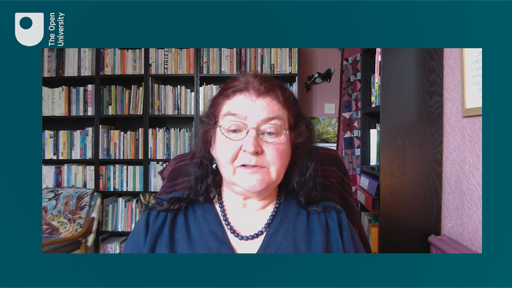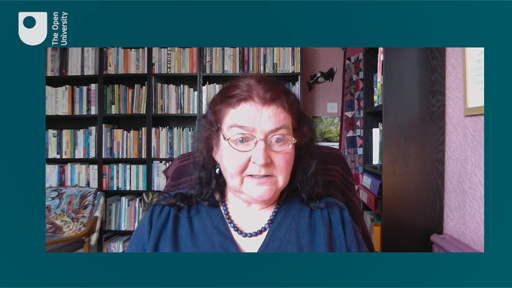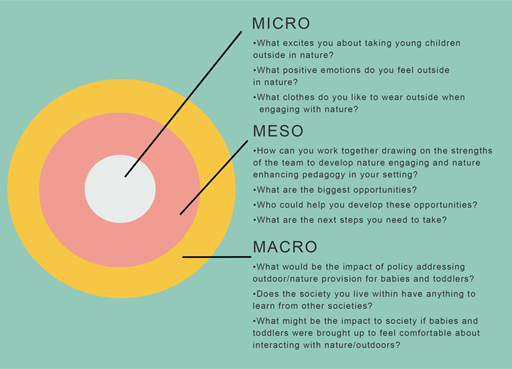1.2 What big questions should we be asking?
In the previous section the questions you were asking and responding to were questions at a micro (your individual response) and meso (the setting context) level. But there also questions that should be asked at a more macro (societal) level. Figure 2 illustrates the possible differences between these levels of questions. Once more, a positive creative response has been taken, rather than focusing on the challenges.
Now watch the following video where Jan White answers the question: What are the big questions we should be asking?

Transcript
JAN WHITE: It really, it all comes down to why. Why do young children need to be outdoors? Why is it not a nice thing to do, but a necessary thing to do. I've certainly come to the opinion that it's a right of children to be outdoors. And this applies right from birth. But why should young children be outdoors and why, in particular, should they be in a nature-rich environment? I think if I start answering that one first, I think I'd like to start with a quotation that I've got from the wonderful Jim Greenman who was an American who was the founder of Bright Horizons nursery.
Well, huge programme of work. And he wrote a book called Caring Spaces Learning Places. It's published in America. But I believe it's available here. He said human beings evolved outdoors. Our bodies need sunlight and fresh air. Our minds need the experiences and challenges that nature presents. Our souls need the day-to-day appreciation for the miracle of the world and all its complexity.
I found myself getting emotional there because I think actually that's one of the foundational things is that our spirits, not just our minds and bodies need to be outdoors, but our spirits require it. And I agree with him that we evolved outdoors over many millennia, many, many millennia. And our bodies and minds and spirits expect to live in the outdoors. And in fact, child development is crafted by the outdoor environment and the requirements of being in the outdoors.
Yes, we had shelters to live in always. We've always needed that, but we've basically until recent times lived an outdoor life. And everything about us requires the outdoors, which means a nature-filled environment, not a nature-depleted environment. So I think that the thinking about the why of why young children must be outdoors for their health, happiness, wellbeing, and futures is one of the huge questions we must be asking. And I don't feel like we've been asking that question enough for many, many decades even.
Jan poses a very simple ‘big’ question: ‘Why should young children be outside?’ She emphasises that this is a question that we have stopped asking for many decades – why do you think this might be the case?
You may have noted ideas such as health and safety concerns, worries over stranger danger, issues with air pollution or that there are a lack of green spaces, particularly for children who live in urban areas. Those of you who work in settings may also acknowledge the difficulties that routines can offer or having to stick to prescriptive curricula guidelines. Now watch the next section of the video where, as Jan continues with her questioning, she picks up many of the threads woven throughout this course.

Transcript
JAN WHITE: And I wonder if associated with that is why have we lost this understanding. When I was a baby, my mum told me, I slept outdoors in a big Silver Cross pram until I was three. And I had long afternoon naps. When I say slept outdoors, I do mean in the daytime. I had long afternoon naps under a tree. And often I've seen it too that the baby will wake up and lie there happily for some time, not immediately wake up and need attention, but the feeling, the sensation, the cool, the fresh air moving around you and things moving.
Make you feel good. And so the child who's had a long sleep outside has, feels good about living and feels good after they've woken up. So why have we lost the understanding that young children should be in the outdoors? I do think this is a Western phenomenon. It's not the whole world that's lost this understanding, but in our cultures we have. And again, associated I think is why have we let the concerns and fears come more important and drive us more than the understanding of the benefits and the need for being in the outdoors.
So that's one big set of whys. That one's a big set of questions I mean. And another question I have is, and I'm so grateful that you've been doing the research that you have been doing, is that why has there been such a lack of attention to this age group. I think when over the last decade, there's been a great deal more research on children from birth to two, but there's an absolute paucity and there continues to be a paucity of research and investigation into babies and toddlers being outdoors. And that's a very worrying and big question is to why have we not been attending to this enough.
And that's left providers in a state of concern and vulnerability because they haven't got the evidence-backed thinking to work with, to help them understand the benefits and the need to be outdoors. And so I guess the concerns and vulnerabilities let's face it, is overtaken Western British life the last couple of decades. And those fears and concerns have just become so much bigger than the understanding of the benefits. So we do need a great deal more inquiry and support into why and how young children need to be outdoors and in nature.
To conclude this section, although there will be micro type questions that practitioners will want to ask in terms of how things would work at a practical level, encourage yourself to ask, and keep on asking, much bigger questions as well. These are questions, not just about what children will enjoy and will be of benefit to their learning, but also questions about what it is to be human. Especially, what it is to be human in a world where there are important issues with how humankind has interacted with the environment up to this point. Questions around what it means to be a baby at this time in environmental history, and if we have the view of a child as competent, then when does their responsibility to the environment kick in. If we are saying that young children do have a responsibility then how do we respond to this through the pedagogies we provide. As you can see – lots of questions!

